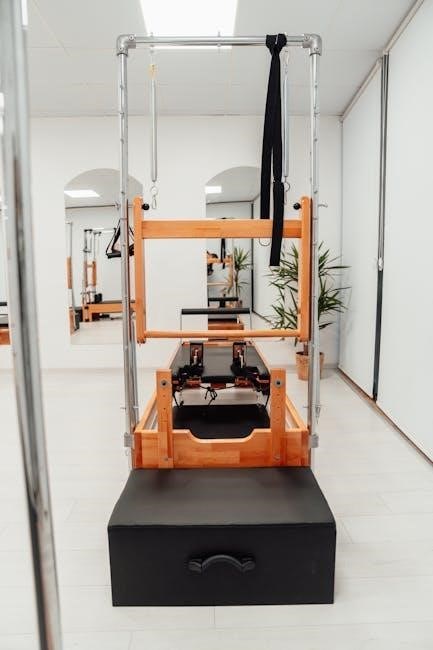The imlovinlit.com Answer Key PDF is a valuable resource designed to support academic success. It provides accurate answers and guidance for various educational materials‚ helping students enhance their understanding and comprehension. This tool is particularly beneficial for self-assessment and identifying areas that require further practice‚ aligning with the curriculum standards set by imlovinlit.com.
Overview of imlovinlit.com Educational Resources
imlovinlit.com offers a wide range of educational resources designed to support teachers and students in various subjects‚ including grammar‚ literature‚ writing‚ poetry‚ and informational text. These resources are structured to align with curriculum standards‚ providing comprehensive lessons and activities for different grade levels. From interactive notebooks to no-prep worksheets‚ the materials are crafted to engage students and simplify teaching. The resources cater to diverse learning needs‚ promoting critical thinking and skill development. They are ideal for classroom instruction‚ independent study‚ and supplementary learning‚ ensuring a well-rounded educational experience. The imlovinlit.com resources are praised for their flexibility‚ adaptability‚ and ability to enhance both teaching and learning outcomes effectively.
Importance of Answer Keys in Educational Materials
Answer keys play a crucial role in educational materials by providing students and educators with a reliable reference for correct answers. They enable self-assessment‚ allowing learners to identify strengths and areas needing improvement. Answer keys also facilitate immediate feedback‚ which is essential for understanding mistakes and reinforcing learning. For educators‚ they serve as a time-saving tool for grading and monitoring progress. The imlovinlit.com Answer Key PDF specifically supports skill development by offering clear explanations and promoting critical thinking. By aligning with curriculum standards‚ these keys ensure accuracy and relevance‚ making them an indispensable resource for effective teaching and learning. They are designed to enhance comprehension and problem-solving abilities‚ fostering academic growth and confidence in students.

What is the imlovinlit.com Answer Key PDF?
The imlovinlit.com Answer Key PDF is an educational resource providing correct answers for various practice assessments and activities. It aligns with curriculum standards‚ offering clarity and accuracy to support learning and skill development through self-assessment.
Definition and Purpose of the Answer Key
The imlovinlit.com Answer Key is a comprehensive educational resource designed to provide correct answers for various practice assessments‚ activities‚ and exercises. Its primary purpose is to support both teachers and students by offering a reliable reference for grading assignments and self-assessment. The answer key aligns with curriculum standards‚ ensuring that students receive accurate feedback to enhance their learning. It is particularly useful for identifying areas where students may need additional practice‚ promoting skill development and academic growth. By providing clear and precise answers‚ the answer key facilitates effective instruction and helps students achieve their educational goals.
Key Features of the imlovinlit.com Answer Key
The imlovinlit.com Answer Key is a comprehensive resource offering accurate and detailed solutions for educational assessments and activities. It is designed to align with curriculum standards‚ ensuring relevance and effectiveness for both students and educators. The answer key is organized clearly‚ making it easy to navigate and use alongside complementary resources like the Interactive Reading Literature Notebook. It supports self-assessment and independent study‚ allowing students to identify areas for further practice. Additionally‚ the answer key is available in PDF format and through Google Forms for self-grading assessments‚ providing flexibility and convenience. These features make it an indispensable tool for enhancing learning outcomes and academic success.

How to Access the imlovinlit.com Answer Key PDF
Access the imlovinlit.com Answer Key PDF through direct downloads or Google Forms for self-grading assessments. Troubleshooting guides are also available to resolve common access issues.
Direct Download Options
The imlovinlit.com Answer Key PDF is readily available for direct download‚ ensuring easy access to educational resources. Users can download the PDF from the official website or through linked resources provided by Erin Cobb. The PDF is compatible with various devices‚ making it accessible for both teachers and students. Once downloaded‚ the answer key can be used to check answers‚ identify areas for improvement‚ and enhance learning. Direct downloads eliminate the need for complex setups‚ allowing immediate access to the material. This convenience ensures that users can focus on their studies without delays. The PDF format also guarantees clarity and readability‚ making it a reliable tool for academic success.
Using Google Forms for Self-Grading Assessments
Google Forms offers a seamless way to access self-grading assessments aligned with the imlovinlit.com Answer Key PDF. These forms are pre-set with answer keys‚ allowing students to input their responses and receive immediate feedback. Users can access these forms via links provided on Erin Cobb’s website‚ ensuring a hassle-free experience. The self-grading feature saves time for educators‚ as results are automatically calculated. Students benefit from instant scoring‚ which helps them track their progress and identify areas for improvement. This integration enhances the learning process‚ making it interactive and efficient. By leveraging Google Forms‚ users can maximize the potential of the imlovinlit.com Answer Key PDF for both independent study and classroom use.
Troubleshooting Common Access Issues
Accessing the imlovinlit.com Answer Key PDF is generally straightforward‚ but users may encounter issues such as expired links or permission restrictions. To resolve these‚ ensure you are using the correct URL or verify the link source. If prompted‚ make sure you have the necessary permissions or access rights. For Google Forms assessments‚ check that you are logged into the correct account and that the form is shared appropriately. If issues persist‚ contact the resource provider or refer to the support materials available on imlovinlit.com. Always ensure you are accessing resources through official channels to avoid unauthorized use.

Benefits of Using the imlovinlit.com Answer Key
Using the imlovinlit.com Answer Key PDF enhances learning by providing immediate feedback‚ improving problem-solving skills‚ and fostering self-assessment. It boosts confidence and engagement while ensuring clarity in understanding complex concepts.
Enhancing Student Understanding and Comprehension
The imlovinlit.com Answer Key PDF plays a crucial role in enhancing student understanding by providing clear and accurate answers to educational exercises. It supports interactive learning resources‚ such as the Interactive Reading Literature Notebook‚ ensuring students grasp complex concepts effectively. The answer key aligns with curriculum standards‚ making it a reliable tool for reinforcing lessons. By offering detailed explanations‚ it helps students connect their responses to the correct answers‚ fostering deeper comprehension. This resource is particularly valuable for self-study‚ allowing learners to identify gaps in their knowledge and focus on areas needing improvement‚ thereby strengthening their overall academic performance and confidence.
Identifying Areas for Further Practice
The imlovinlit.com Answer Key PDF is an essential tool for pinpointing gaps in student knowledge and skills. By comparing their answers with the provided solutions‚ students can easily identify where they need additional practice. This resource aligns with curriculum standards‚ ensuring that the areas highlighted for further practice are relevant and aligned with learning objectives. Educators can use the answer key to create targeted study plans‚ focusing on specific skills or topics where students struggle. This personalized approach not only enhances learning but also builds confidence and encourages critical thinking‚ making it a valuable asset for both students and educators in achieving academic success.
Developing Problem-Solving Skills
The imlovinlit.com Answer Key PDF plays a crucial role in enhancing problem-solving abilities by providing clear explanations and solutions. Students can analyze their mistakes and understand the reasoning behind correct answers‚ fostering critical thinking. This resource encourages learners to apply knowledge in different contexts‚ improving their capacity to tackle various challenges. Educators can use the answer key to design targeted exercises‚ helping students overcome specific difficulties. By aligning with curriculum standards‚ it ensures that problem-solving skills are developed in a structured and effective manner. This tool not only aids in academic success but also prepares students for future learning by fostering analytical and creative thinking.

Structure and Content of the Answer Key
The imlovinlit.com Answer Key PDF is organized to ensure clarity and ease of use. It includes comprehensive solutions‚ aligned with curriculum standards‚ and covers a wide range of educational topics such as grammar‚ literature‚ and vocabulary. The content is structured logically‚ making it easy for students and educators to navigate and find the necessary information quickly. This resource is designed to provide accurate and detailed answers‚ supporting effective learning and teaching experiences.
Comprehensive Coverage of Educational Topics
The imlovinlit.com Answer Key PDF offers extensive coverage of various educational topics‚ ensuring a well-rounded learning experience. It includes detailed solutions for grammar‚ vocabulary‚ reading comprehension‚ and literature analysis‚ making it a versatile tool for students. The resource is designed to align with curriculum standards‚ providing accurate and relevant answers for exercises and assessments. Additionally‚ it covers topics like roots‚ prefixes‚ and suffixes‚ as well as informational text skills‚ catering to diverse learning needs. This comprehensive approach ensures that students gain a deep understanding of key concepts‚ while educators can rely on it for consistent and reliable support in teaching and grading.
Alignment with Curriculum Standards
The imlovinlit.com Answer Key PDF is carefully designed to align with curriculum standards‚ ensuring relevance and effectiveness in educational settings. It supports skills such as grammar‚ literature‚ writing‚ poetry‚ and informational text analysis‚ catering to specific grade-level requirements. The resource integrates seamlessly with teaching objectives‚ providing accurate answers and clear explanations for exercises and assessments. By adhering to established educational guidelines‚ the answer key helps educators deliver consistent instruction while enabling students to meet learning benchmarks. This alignment ensures that the material is both comprehensive and targeted‚ fostering academic growth and preparing students for future challenges.
Clarity and Accuracy in Answer Presentation
The imlovinlit.com Answer Key PDF is renowned for its clear and precise presentation of answers‚ ensuring students and educators can easily understand and apply the solutions. Each answer is thoughtfully formatted‚ often with color-coded sections and step-by-step explanations‚ to enhance comprehension. The resource avoids ambiguity‚ providing unambiguous correct responses that align with the questions posed in the educational materials. This clarity not only aids in identifying errors but also fosters a deeper understanding of the subject matter. The accuracy of the answers is meticulous‚ reflecting the high standards of educational content provided by imlovinlit.com‚ making it a reliable tool for learning and assessment.

Integration with Other Educational Resources
The imlovinlit.com Answer Key PDF seamlessly integrates with other educational tools‚ such as the Interactive Reading Literature Notebook and No-Prep Worksheets‚ enhancing teaching and learning experiences effectively.
Compatibility with Interactive Reading Literature Notebook
The imlovinlit.com Answer Key PDF is specifically designed to complement the Interactive Reading Literature Notebook‚ ensuring a seamless integration for both teachers and students. This compatibility allows educators to align the answer key with lesson plans‚ providing immediate feedback and enhancing the learning process. By pairing these resources‚ students can deepen their understanding of literary concepts and skills‚ while teachers can efficiently track progress and adjust instruction. The answer key supports the notebook’s interactive elements‚ making it easier for learners to grasp complex ideas and apply them in their studies. This integration creates a cohesive educational experience‚ fostering engagement and academic growth.
Supplementing Reading Informational Text Resources
The imlovinlit.com Answer Key PDF serves as an excellent supplement to Reading Informational Text resources‚ providing students with clear and accurate answers to practice exercises. This resource aligns perfectly with the skills and standards taught in informational text lessons‚ ensuring consistency and reinforcement of key concepts. By using the answer key‚ students can verify their understanding of complex texts‚ identify strengths and weaknesses‚ and refine their critical thinking skills. Additionally‚ the answer key supports differentiated instruction‚ allowing educators to cater to diverse learning needs. Its flexibility makes it an invaluable tool for enhancing the effectiveness of Reading Informational Text resources in various educational settings. This integration fosters deeper comprehension and promotes academic success for all learners.
Using the Answer Key with No-Prep Worksheets
The imlovinlit.com Answer Key PDF seamlessly integrates with no-prep worksheets‚ offering a time-saving solution for educators. These worksheets are designed to align with interactive notebook lessons‚ providing students with structured practice without requiring extensive preparation. The answer key complements these resources by offering correct responses‚ enabling students to self-assess and identify areas needing improvement. This combination enhances learning efficiency‚ as students can independently verify their answers and gain clarity on complex concepts. The flexibility of the answer key ensures it can be adapted to various classroom needs‚ making it an invaluable tool for both teachers and learners. This integration simplifies teaching and reinforces student understanding effectively.

Tips for Educators Using the Answer Key
Educators can enhance instruction by using the answer key to create targeted lessons‚ monitor progress‚ and encourage critical thinking. It ensures effective and engaging teaching strategies.
Enhancing Instruction with Answer Keys
Educators can significantly enhance instruction by utilizing the imlovinlit.com Answer Key PDF to align lessons with curriculum standards. By integrating these keys into daily instruction‚ teachers can provide immediate feedback‚ encouraging critical thinking and analysis; The answer key enables educators to identify student knowledge gaps‚ allowing for targeted interventions and differentiated instruction. Additionally‚ it supports the development of problem-solving skills by offering clear explanations for complex concepts. Teachers can also use the answer key to create self-grading assessments via Google Forms‚ promoting active learning and engagement. This resource ensures that instruction remains effective‚ engaging‚ and tailored to student needs‚ fostering a deeper understanding of the material.
Monitoring Student Progress Effectively
The imlovinlit.com Answer Key PDF serves as a powerful tool for tracking student progress. Educators can use it to assess comprehension‚ identify strengths‚ and pinpoint areas needing improvement. By reviewing answers‚ teachers gain insights into individual and class-wide performance‚ enabling targeted support. The answer key also facilitates self-assessment‚ allowing students to evaluate their work independently. This resource promotes timely interventions and ensures students grasp essential concepts before advancing. Regular use of the answer key helps maintain academic momentum and fosters a data-driven approach to learning‚ making it easier to adapt instruction and meet student needs effectively.
Encouraging Critical Thinking and Analysis
The imlovinlit.com Answer Key PDF encourages critical thinking by providing detailed explanations for answers‚ helping students understand the reasoning behind correct responses. This fosters analytical skills as learners evaluate their own work and explore alternative solutions. The resource promotes deeper engagement with material‚ allowing students to move beyond rote memorization and develop a more thorough understanding of concepts. By aligning with curriculum standards‚ the answer key ensures that critical thinking exercises are relevant and effective. Educators can use it to design lessons that challenge students to think independently and solve problems creatively‚ making it a valuable tool for nurturing intellectual growth and academic excellence.

Student Guide to Using the Answer Key
Students can use the imlovinlit.com Answer Key PDF for self-assessment‚ allowing them to check their work independently and identify areas for improvement without instructor input.
Maximizing Learning with Answer Key Resources
Students can maximize their learning by effectively utilizing the imlovinlit.com Answer Key PDF. This resource provides clear and accurate answers‚ enabling students to identify gaps in their understanding and focus on areas needing improvement. By reviewing incorrect answers and understanding the reasoning behind correct ones‚ students can enhance their problem-solving skills and comprehension. The answer key also supports independent study‚ allowing learners to work at their own pace and reinforce concepts taught in class. Regular use of this tool fosters critical thinking and promotes academic growth‚ ensuring students are well-prepared for assessments and future challenges.
Independent Study and Self-Assessment
The imlovinlit.com Answer Key PDF is an excellent tool for independent study and self-assessment. Students can use it to review their work‚ verify answers‚ and understand their mistakes. This resource encourages learners to take ownership of their education by identifying areas where they need more practice. The answer key supports self-directed learning‚ allowing students to study at their own pace and reinforce concepts taught in class. It also helps students develop a growth mindset by enabling them to track their progress and build confidence in their abilities. Regular use of the answer key fosters independence and accountability‚ making it an invaluable supplement to traditional classroom instruction.
Avoiding Misuse of Answer Keys
To ensure the imlovinlit.com Answer Key PDF is used effectively‚ it’s important to avoid misuse. Students should not rely solely on the answer key without attempting the questions first‚ as this can hinder their ability to grasp concepts independently. The answer key should be used as a tool for verification and understanding‚ not as a shortcut to skip the learning process. Educators should emphasize critical thinking and encourage students to analyze their mistakes rather than simply copying the correct answers. Proper guidance and monitoring are essential to prevent the answer key from undermining the educational value of the materials. Misusing the resource can lead to a lack of deep understanding and diminished academic growth.

The Role of Answer Keys in Academic Success
The imlovinlit.com Answer Key PDF plays a crucial role in academic success by providing students with accurate answers and guidance. It helps students understand their mistakes‚ identify areas needing improvement‚ and reinforces learning by aligning with curriculum standards‚ ensuring effective and meaningful education.
Building Confidence in Learning
The imlovinlit.com Answer Key PDF plays a significant role in building students’ confidence by providing clear and accurate answers. It allows learners to verify their work‚ understand their strengths‚ and identify areas for improvement. By having access to correct answers‚ students can independently assess their progress‚ fostering a sense of accomplishment and reducing anxiety. This resource also encourages self-directed learning‚ as students can review their mistakes and retry questions‚ leading to better retention and mastery of concepts. Over time‚ this consistent practice and feedback build resilience and confidence‚ empowering students to approach challenges with greater assurance and readiness for future academic success;
Promoting Active Learning and Engagement
The imlovinlit.com Answer Key PDF fosters active learning by enabling students to engage interactively with educational content. Through self-assessment‚ learners can verify their answers and receive immediate feedback‚ enhancing their involvement in the learning process. The integration with self-grading Google Forms assessments adds a dynamic element‚ making tasks more engaging and motivationally rewarding. Additionally‚ the alignment of the answer key with curriculum standards ensures relevance and structure‚ keeping students interested and focused. By supporting independent study and critical thinking‚ the resource encourages a deeper connection with the material‚ ultimately promoting a more engaging and effective learning experience.
Providing Immediate Feedback and Guidance
The imlovinlit.com Answer Key PDF serves as a powerful tool for providing immediate feedback and guidance to students. By offering correct answers to exercises and assessments‚ it enables learners to quickly identify areas where they may need additional support. This instant feedback fosters a deeper understanding of the material and helps students correct mistakes promptly. The self-grading Google Forms assessments further enhance this feature‚ allowing for real-time results and personalized guidance. Such immediate feedback not only improves learning outcomes but also builds confidence and encourages students to take an active role in their educational journey. This resource is designed to support effective and meaningful learning experiences.

Staying Updated with imlovinlit.com Resources
Imlovinlit.com regularly updates its educational materials‚ including the Answer Key PDF‚ to ensure users have access to the latest resources and support. These updates align with curriculum changes and provide fresh content to enhance teaching and learning experiences. The platform also offers tools like Google Forms for self-grading assessments‚ ensuring resources remain relevant and user-friendly. By staying updated‚ educators and students can benefit from new features and improved materials designed to meet their evolving needs.
Regular Updates and New Releases
Imlovinlit.com consistently releases updated versions of its Answer Key PDF to ensure alignment with curriculum standards and educational needs. These updates often include new questions‚ revised answer explanations‚ and additional practice materials to support learning. The platform listens to educator feedback‚ incorporating suggestions to improve resource quality. Regular updates also expand coverage of topics‚ such as grammar‚ vocabulary‚ and reading comprehension‚ ensuring comprehensive support for students. By periodically refreshing its materials‚ imlovinlit.com helps educators stay current with teaching trends and provides students with relevant‚ engaging content. This commitment to updates ensures the Answer Key PDF remains a reliable and dynamic educational tool.
Accessing Support and Additional Materials
Imlovinlit.com offers comprehensive support and additional materials to enhance the use of its Answer Key PDF. Educators and students can easily access supplementary resources‚ such as interactive notebooks‚ reading comprehension guides‚ and vocabulary practice worksheets‚ all aligned with the Answer Key. The platform provides a dedicated support section on its website‚ featuring FAQs‚ email assistance‚ and a community forum for educators to share ideas and resolve queries. Additionally‚ imlovinlit.com regularly updates its resources to ensure they remain relevant and effective. Users can also explore the Teachers Pay Teachers store for more educational tools designed to complement the Answer Key PDF‚ ensuring a seamless and enriched learning experience.
The imlovinlit.com Answer Key PDF is a valuable resource that supports academic success and fosters future learning. It provides clarity‚ accuracy‚ and comprehensive guidance for educators and students alike.
Final Thoughts on the imlovinlit.com Answer Key PDF
The imlovinlit.com Answer Key PDF is an indispensable resource for educators and students‚ offering clear and accurate solutions to educational materials. It promotes self-assessment‚ identifies areas for improvement‚ and enhances problem-solving skills. By aligning with curriculum standards and integrating seamlessly with other resources like the Interactive Reading Literature Notebook‚ it provides a comprehensive learning experience. Its flexibility and adaptability make it a valuable tool for diverse educational needs. Encourage effective use of this resource to maximize its benefits and support academic growth. The imlovinlit.com Answer Key PDF is a testament to the commitment of creating high-quality educational materials for successful learning outcomes.
Encouragement to Utilize the Resource Effectively
Embrace the imlovinlit.com Answer Key PDF as a powerful tool to elevate learning outcomes. Encourage students to use it for self-assessment‚ fostering independence and critical thinking. Educators can leverage the answer key to monitor progress‚ identify skill gaps‚ and tailor instruction. By integrating it with other resources like the Interactive Reading Literature Notebook and No-Prep Worksheets‚ create a cohesive learning environment. Promote consistent practice and review to maximize its benefits. This resource is not just for grading but for growth‚ helping students build confidence and mastery. Encourage its effective use to unlock its full potential and support a deeper understanding of educational concepts.




























































